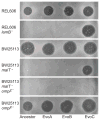Repeatability and contingency in the evolution of a key innovation in phage lambda
- PMID: 22282803
- PMCID: PMC3306806
- DOI: 10.1126/science.1214449
Repeatability and contingency in the evolution of a key innovation in phage lambda
Abstract
The processes responsible for the evolution of key innovations, whereby lineages acquire qualitatively new functions that expand their ecological opportunities, remain poorly understood. We examined how a virus, bacteriophage λ, evolved to infect its host, Escherichia coli, through a novel pathway. Natural selection promoted the fixation of mutations in the virus's host-recognition protein, J, that improved fitness on the original receptor, LamB, and set the stage for other mutations that allowed infection through a new receptor, OmpF. These viral mutations arose after the host evolved reduced expression of LamB, whereas certain other host mutations prevented the phage from evolving the new function. This study shows the complex interplay between genomic processes and ecological conditions that favor the emergence of evolutionary innovations.
Figures





Comment in
-
Evolution. The role of coevolution.Science. 2012 Jan 27;335(6067):410-1. doi: 10.1126/science.1217807. Science. 2012. PMID: 22282796 No abstract available.
Similar articles
-
The role of side tail fibers during the infection cycle of phage lambda.Virology. 2019 Jan 15;527:57-63. doi: 10.1016/j.virol.2018.11.005. Epub 2018 Nov 18. Virology. 2019. PMID: 30463036 Free PMC article.
-
Evolution. The role of coevolution.Science. 2012 Jan 27;335(6067):410-1. doi: 10.1126/science.1217807. Science. 2012. PMID: 22282796 No abstract available.
-
Adsorption of bacteriophage lambda on the LamB protein of Escherichia coli K-12: point mutations in gene J of lambda responsible for extended host range.J Bacteriol. 1994 Feb;176(4):941-7. doi: 10.1128/jb.176.4.941-947.1994. J Bacteriol. 1994. PMID: 8106335 Free PMC article.
-
Interaction of bacteriophage l with its E. coli receptor, LamB.Viruses. 2012 Nov 15;4(11):3162-78. doi: 10.3390/v4113162. Viruses. 2012. PMID: 23202520 Free PMC article. Review.
-
[Escherichia coli phage receptors. Minor porins and proteins participating in the specific transport as phage receptors].Mol Gen Mikrobiol Virusol. 1989 Dec;(12):3-12. Mol Gen Mikrobiol Virusol. 1989. PMID: 2561376 Review. Russian.
Cited by
-
Multi-scale structure and geographic drivers of cross-infection within marine bacteria and phages.ISME J. 2013 Mar;7(3):520-32. doi: 10.1038/ismej.2012.135. Epub 2012 Nov 22. ISME J. 2013. PMID: 23178671 Free PMC article.
-
Phage resistance mutations affecting the bacterial cell surface increase susceptibility to fungi in a model cheese community.ISME Commun. 2024 Aug 2;4(1):ycae101. doi: 10.1093/ismeco/ycae101. eCollection 2024 Jan. ISME Commun. 2024. PMID: 39296780 Free PMC article.
-
Emergence of a Competence-Reducing Filamentous Phage from the Genome of Acinetobacter baylyi ADP1.J Bacteriol. 2016 Nov 4;198(23):3209-3219. doi: 10.1128/JB.00424-16. Print 2016 Dec 1. J Bacteriol. 2016. PMID: 27645387 Free PMC article.
-
Evolutionary Trajectories are Contingent on Mitonuclear Interactions.Mol Biol Evol. 2023 Apr 4;40(4):msad061. doi: 10.1093/molbev/msad061. Mol Biol Evol. 2023. PMID: 36929911 Free PMC article.
-
Leaky resistance and the conditions for the existence of lytic bacteriophage.PLoS Biol. 2018 Aug 16;16(8):e2005971. doi: 10.1371/journal.pbio.2005971. eCollection 2018 Aug. PLoS Biol. 2018. PMID: 30114198 Free PMC article.
References
-
- Mayr E. Animal Species and Evolution. Belknap Press; Cambridge, MA: 1963.
-
- Gavrilets S. In: Toward an Extended Evolutionary Synthesis. Pigliucci M, Muller G, editors. MIT Press; Cambridge, MA: 2010.
-
- Darwin C. The Origin of Species. Murray; London: 1859.
-
- Fisher RA. The Genetical Theory of Natural Selection. Clarendon Press; Oxford: 1930.
-
- Dieckmann U, Doebeli M, Metz JAJ, editors. Adaptive Speciation. Cambridge Univ. Press; Cambridge, UK: 2004.

